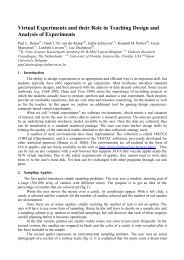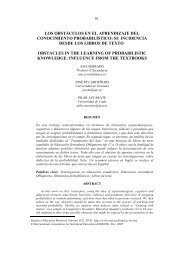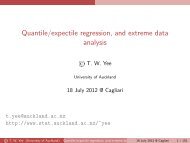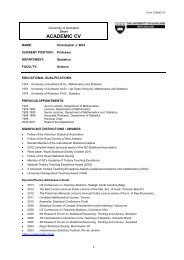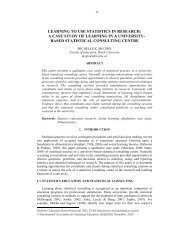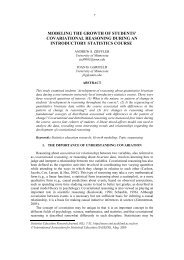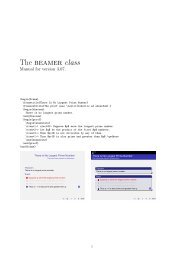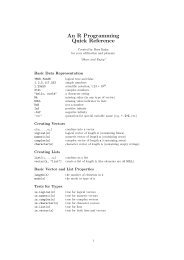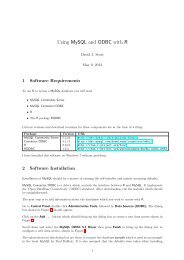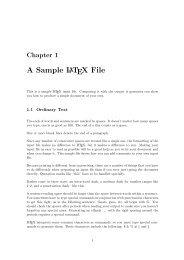PERMDISP - Department of Statistics
PERMDISP - Department of Statistics
PERMDISP - Department of Statistics
Create successful ePaper yourself
Turn your PDF publications into a flip-book with our unique Google optimized e-Paper software.
Type the name <strong>of</strong> the input file containing your data<br />
Tim.txt<br />
7<br />
Type a name for the output file <strong>of</strong> results (*.txt)<br />
Results.txt<br />
Note: If the program crashes it may be because you already have a file in the directory with the same name<br />
as what you are typing here for the output file. If so, then you need to delete the previous file or type a new<br />
name. Unfortunately, the program is not smart enough to write over the top <strong>of</strong> an existing file.<br />
Nature <strong>of</strong> the data in the input file:<br />
1) raw data (n x p)<br />
2) distance matrix (n x n)<br />
1<br />
Structure <strong>of</strong> the input file:<br />
1) rows are samples and columns are variables<br />
2) columns are samples and rows are variables<br />
1<br />
How many variables (columns) are there?<br />
46<br />
Choice <strong>of</strong> transformation:<br />
1) none<br />
2) square-root<br />
3) fourth-root<br />
4) ln(x)<br />
5) ln(x+1)<br />
6) log10(x)<br />
7) log10(x+1)<br />
5) presence/absence<br />
3<br />
Choice <strong>of</strong> standardization:<br />
1) none<br />
2) standardize by row (sample) sums<br />
3) standardize by column (variable) sums<br />
4) double standardize by row and column sums<br />
5) standardize each variable to z-scores (normalize)<br />
6) standardize each variable by dividing by its s.d.<br />
7) standardize each variable by dividing by its range<br />
1<br />
Choice <strong>of</strong> distance measure:<br />
1) Bray-Curtis dissimilarity<br />
2) square root <strong>of</strong> Bray-Curtis<br />
3) Euclidean distance<br />
4) Orloci's Chord distance<br />
5) Chi-square metric<br />
6) Chi-square distance<br />
7) Hellinger distance<br />
8) Gower dissimilarity<br />
9) Gower, excluding double zeros<br />
10) Canberra distance<br />
11) square root <strong>of</strong> Canberra distance<br />
12) CY dissimilarity<br />
13) Deviance based on the binomial<br />
14) Deviance per observation (scale invariant)<br />
15) Kulczynski dissimilarity<br />
16) McArdle-Gower dissimilarity<br />
17) Manhattan (city block) distance<br />
18) Jaccard dissimilarity<br />
1<br />
Note: The same options were used here for the analysis as were chosen for the PERMANOVA <strong>of</strong> these<br />
data (see the PERMANOVA user notes). This was done so that the null hypothesis <strong>of</strong> no differences in



